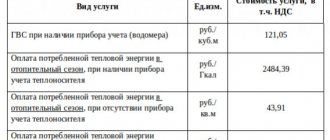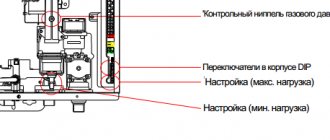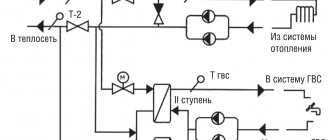New in blogs
How to convert gigacalories to cubic meters
When receiving utility bills, it is quite difficult to understand many aspects of the calculations and understand: where did this or that figure come from? One of the most striking examples of such “translation difficulties” is payment for supplied heat. If your home has a single heat meter installed, then you will receive bills for the Gcal (gigacalories) used, but the tariff for hot water, as you know, is set for cubic meters. How to figure out how to calculate the cost of heat?
Instructions
1
Perhaps the greatest difficulty lies precisely in the technical impossibility of converting gigacalories into cubic meters or vice versa. These are completely different physical quantities: one serves to measure thermal energy, the other – volume, and, as a basic physics course suggests, they are incomparable. The task of the utility consumer ultimately comes down to calculating the ratio of the amount of heat expended and the volume of hot water consumed.
2
In order not to get completely confused, it is worth starting with determining the calculated values. So, by calorie we mean the amount of heat that is necessary to heat one cubic centimeter of water by 1°C. There are a billion calories in a Gcal, and a million centimeters in a cubic meter, therefore, to heat one cubic meter of water by 1°C you will need 0.001 Gcal.
Considering that hot water should not be colder than 55°C, and cold water arrives at a temperature of 5°C, it is obvious that it will need to be heated by 50°C, that is, spend 0.05 Gcal of thermal energy on each cubic meter. In the sphere of housing and communal services tariffs, there is a slightly higher heat consumption standard for heating one cubic meter of water - 0.059 Gcal, this is due to heat losses that occur when transporting water through a pipeline.
3
Then everything is simple, divide the heat consumption according to the readings of the house meter by the number of residents. In this way, obtain the heat consumption for each resident, and dividing the resulting figure by the standard 0.059 is the volume of hot water in cubic meters that must be paid for by each resident. The only subtlety in this calculation is the need to subtract from it those residents who have consumption meters installed in their apartment.
4
Let's consider the calculation using an example: the consumption according to a common house meter was 30 Gcal, residents who have internal metering devices used a total of 35 m³ of hot water, residents without metering devices in the house - 75 people.
5
We count:
35*0.059 = 2.065 – this is the amount of heat consumed by residents who have metering devices;
30-2.065 = 27.935 Gcal – the balance of consumption for the remaining residents;
27.935/75 = 0.372 Gcal – heat consumption per resident;
0.372/0.059 = 6.31 m³ of hot water will be billed to each tenant whose apartments are not equipped with metering devices.
More details: https://www.kakprosto.ru/kak-108400-kak-perevesti-gigakaloriyu-v-kubicheskie-metry#ixzz2mtUe7egh
How to convert Gcal?
To find out how many Gcal is obtained, you need to multiply the available number of kW by a constant value, 0.00086. Let's look at an example. Suppose you need to convert 250 kW into calories. 250 kW x 0.00086 = 0.215 Gcal/hour.
Interesting materials:
What is povidone used for? What is silk used for? What is SID for? What is a scoop for? What is the footer tag for? What is a nail topper for? Why do you need turbo mode in a blender? What is vitamin B 12 for? Why do you need an external static IP address? Why do you need an admin panel on a website?
Why do I pay for heating in the summer?
Why do I pay for heating in the summer?
Heating charges can be charged either only during the heating season (as in the examples above) or all year round.
The same amounts are obtained per year, but the first method is simpler and, most importantly, it is transparent for the recipient of the receipt. The second method is quite complicated and often causes confusion among residents. In this case, all heating costs for the year are added up and divided by twelve.
The Petrovs have the same apartment as the Ivanovs, but the local administration chose the second method, payment during the calendar year. There are no meters.
Let the heating season last 7 months. Divide 7 by 12 to get approximately 0.58. Let's multiply by the number obtained in the first example: 0.58 × 1170 = 678.6 rubles. This is the amount you will have to pay for heating every month throughout the year.
It is not difficult to calculate that in a year the total amount will be the same as the Ivanovs (from the first example) for seven months of the heating season.
If there is a house or apartment meter, and the fee is calculated in the second way, everything is not so simple. It is not the latest meter readings that are taken into account, but the average monthly heat consumption for the past year (total heat for the entire heating season divided by twelve). Or, if the meter has just been installed, the same “heating standards”.
The result, naturally, never coincides with reality, and at the beginning of next year it has to be corrected. Therefore, deductions or additional payments appear on receipts - so that the amount that appears on the meter is obtained.
In Novosibirsk, by decree of the regional governor, this method was adopted.
However, it is so inconvenient (especially for residents) that many management companies unofficially allow payment “based on consumption.” That is, in the first, simple and understandable way.
When you need to dot all the i’s
But a completely reasonable question arises: “How to count something that is invisible and can disappear instantly, literally out the window.” There is no need to despair of this struggle with the air; it turns out that there are quite clear mathematical calculations of the calories received for heating.
Moreover, all these calculations are hidden in official documents of state utility organizations. As usual in these institutions, there are several such documents, but the main one is the so-called “Rules for accounting of thermal energy and coolant”. It is he who will help solve the question - how to calculate Gcal for heating.
The actual problem can be solved quite simply and no calculations will be needed if you have a meter not just for water, but for hot water. The readings of such a meter are already “filled” with data on the heat received. When taking readings, you multiply it by the cost tariff and get the result.
Find out also how to hide heating pipes - three main ways.
How many Gcal are in 1 cubic meter of gas? How to convert gas to gigacalories?
I had my own experience of doubting the quality of gas when purchasing a 50-liter gas cylinder for use in the country. I asked a similar question about how the cylinder must somehow be designed for a certain amount of heat released during combustion. To which I received a positive response and even got acquainted with the Gas Quality Certificate, which indicated certain numbers in the table, as an average value based on the data obtained during testing, and even comparative readings in GOST.
I’ll start with GOST; the calorific value is regulated by the document GOST 5542-2014, which specifies two recommended parameters for physical and chemical indicators.
1) Lower calorific value under standard conditions, MJ/m3 (cube) kcal/m3 (cube)
Limit rate above - 31.80 MJ/m3 (7600 kcal/m3)
2) Range of values of the Wobbe number (highest) under standard conditions, MJ/m3 (cube) kcal/m3 (cube)
Limit rate - From 41.20 MJ/m3 to 54.50 MJ/m3 (from 9840 kcal/m3 to 13020 kcal/m3)
Test methods, formulas and calculations are described in the document GOST 31369-2008
Let's return from the documents to your questions, but first I would like to note that, firstly, we are interested in the value of the lower calorific value, since it is this that is more or less true under standard (domestic) operating conditions.
I would also like to note that official documents express data in MJ/m3 and kcal/m3; if they are converted to Gcal/m3, then a coefficient is applied.
Let's start with the first question:
How many Gcal are in 1 cubic meter of gas?
According to GOST, this value is equal to (attention! not less than) 7600 kcal/m3
Second question:
How many Gcal are in 1 liter of gas?
Since all documents regulate a cubic meter, to determine a liter it is necessary to divide by 1000, since there are 1000 liters in 1 m3
7600/1000=7.6 kcal/m3
Third question:
How many Gcal are in 1 50 liter gas cylinder?
If 1 liter contains a minimum of 7.6 kcal/m3, then 50 liters theoretically contain 50 times more
7.6*50=380 kcal/m3
In practice, there are never 50 liters in a cylinder; at most, if there are 40-42 liters, then this is good, you need to focus on a maximum of 40 liters, which means the answer will be:
304 kcal/m3
Fourth question:
How to convert gas to gigacalories?
Let's start with the fact that a Gigacalorie is nothing more than 1,000,000,000 Calories, which reflect a certain amount of heat that must be spent to heat up the water.
1 calorie heats 1 gram of pure water at normal pressure by 1 degree Celsius.
Accordingly, 1 Gcal heats the same water by 1 degree in the amount of 1000 liters.
To convert the heat of gas into Gcal (gigacalories), you need to use a coefficient of 10 to the 9th power, i.e. by one billion.
In addition, I would like to note that all the above standards are minimum standards, the exact ones must be checked with gas sellers, these standards are specified in quality passports.
How much gas per 1 kW?
Comparison of heating costs.
| № | Type of fuel | kW per unit |
| 1 | Natural gas | 8,8-11.6 |
| 2 | Liquefied gas | 10 |
| 3 | Coal | 8 |
| 4 | Diesel fuel | 10 |
Interesting materials:
Who is Max Barskikh's zodiac sign? Who is Gagarin by rank? Who defeated Goro in Mortal Kombat? Who won Mr. Olympia 2022? Who defeated the Nightingale the Robber? Who won in Hell's Kitchen, Olya or Anton? Who won the big races? Who won the KVN 2015 finals? Who won the previous vote? Who won the war between England and Spain?
How is the heat supply fee calculated?
If water supply for domestic needs is assessed using in-house metering devices or approved standards, then the payment for heat supply is calculated based on approved methods.
There are two options for accrual periods:
- For the heating season.
- For a calendar year.
The method for calculating heat supply costs depends on several factors:
- on the type of installed hot water supply system: open or closed;
- from the presence of communal and intra-apartment heat and water supply meters.
The logic of the calculations is the same: distribution of all thermal energy consumed by the house over the area of residential and non-residential heated premises, i.e. Residents pay part of the costs in proportion to the heated area occupied.
The heating fee is equal to: P = Q×S×T, where:
- Q is the amount of thermal energy consumed per 1 m3 of occupied space, including general house expenses;
- S - occupied area;
- T is the tariff for thermal energy established by local authorities.
Tariffs are reviewed annually and approved for each heat supply system individually.
How to calculate the cost of 1 Gcal?
In order to calculate Gcal
in a closed heating system, you must use the following formula: Q = ((V1 * (T1 – T)) – (V2 * (T2 – T))) / 1000, where: Q – the previous volume of thermal energy; V1 is the heat carrier flow rate parameter in the supply pipe.
Interesting materials:
How to log out of your personal account in Tele2? How to log out of your Wildberry account? How to exit Tele2 Personal Account? How to exit NPF Safmar? How to log out of mail on Yandex? How to unsubscribe from Yandex Music? How to exit the mts application? How to exit the tele2 application? How to log out of PSN on PS4? How to log out of Samsung Pay?
How to calculate heating by area?
Often, 100 W of thermal energy is taken as a norm per 1 m2 of area - this is considered the simplest method for those who do the calculation of heating power by volume of the room with their own hands. For calculations, use the formula Q = S×100, where: Q is the required thermal power for the room; S – room area (m²);
Interesting materials:
Where to find Folder Options in Windows 7? Where can I find solitaire on Windows 10? Where to find Realtek on Windows 10? Where can I find a screenshot on Windows 10? Where can I find screenshots in Windows 8? Where can I find services in Windows 10? Where can I find all the programs in Windows 10? Where are the printer drivers in Windows 10? Where are the screensaver files in Windows 7? Where are the Windows 10 Start shortcuts?











